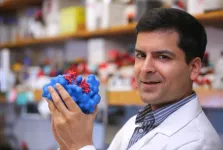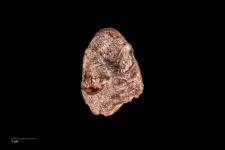(Press-News.org) A team led by Dr. Samie Jaffrey, the Greenberg-Starr Professor of Pharmacology at Weill Cornell Medicine, has been awarded a three-year, $1.65 million grant for RNA research under a biotechnology-development program run by the U.S. National Science Foundation.
The competitive Molecular Foundations for Biotechnology program funds cutting-edge research that lays the groundwork for future clinical and industrial biotechnologies. The new award is one of nine that have been given to research teams across the United States this year, with funding assistance from the National Institutes of Health, to advance the promise of RNA-based therapeutics and other products.
Dr. Jaffrey and co-principal investigator Dr. Matthew Shoulders, a chemistry professor at the Massachusetts Institute of Technology, will use their award to develop general techniques for designing RNAs to have desired biological activities.
“We’re honored to have been chosen for this award, which we hope will enable us to accelerate progress in this challenging, but highly promising, field,” Dr. Jaffrey said.
RNA, ribonucleic acid, is a chemical cousin of DNA and is ubiquitous in cells. Messenger RNA molecules (mRNAs) are single-stranded and work as go-betweens in the conversion of genetic information to proteins. Other, RNAs, called noncoding RNAs, have a variety of regulatory functions, and form parts of important cellular machines such as protein-making ribosomes.
Because RNAs are capable of binding tightly and with high specificity to proteins as well as to other RNAs and DNA, they are viewed as having great potential as therapeutics. Yet their therapeutic use so far has been limited mostly to mRNA-based vaccines, which encode viral proteins to stimulate immune responses.
“RNAs can actually do so much more, and we’re particularly interested in their ability to bind to proteins to create new protein complexes and cellular signaling events,” Dr. Jaffrey said.
Getting RNAs to act as “molecular glue” in this sense is virtually impossible to do with direct design techniques, given the complexity of RNA biology. Scientists generally can’t predict in advance how any large strand of RNA will fold up in a particular cellular environment, and what biological activity it will have. Therefore, Dr. Jaffrey and Dr. Shoulders will develop a more indirect and iterative design approach that mimics biological evolution.
Their system is based on one that Dr. Shoulders developed for evolving therapeutic proteins, which uses a virus that is engineered to replicate as the protein exhibits improved functions. Dr. Jaffrey and Dr. Shoulders have created new viruses that replicate depending on the biological properties of a viral-encoded RNA. As the virus replicates, the RNA undergoes continuous mutations allowing improved RNAs to drive viral replication.
“This system creates a system of Darwinian evolution, where RNAs evolve powerful functions in cells,” Dr. Jaffrey said. “The long-term goal is to use such systems to discover therapeutic RNAs that we could never have even imagined when taking the traditional design approach.”
END
NSF awards grant for evolution-inspired design of therapeutic RNAs
2024-03-21
ELSE PRESS RELEASES FROM THIS DATE:
Best way to bust deepfakes? Use AI to find real signs of life, say Klick Labs scientists
2024-03-21
NEW YORK, NY / TORONTO, ON – March, 21, 2024 – Artificial intelligence may make it difficult for even the most discerning ears to detect deepfake voices – as recently evidenced in the fake Joe Biden robocall and the bogus Taylor Swift cookware ad on Meta – but scientists at Klick Labs say the best approach might actually come down to using AI to look for what makes us human.
Inspired by their clinical studies using vocal biomarkers to help enhance health outcomes, and their fascination with sci-fi films like “Blade Runner,” the Klick ...
The protein that protects insulin-producing cells
2024-03-21
Although there are many differences between type 1 diabetes and type 2 diabetes, there are also similarities, such as inflammation of the insulin-producing cells. Researchers at Lund University have studied a protein called C3, which plays a central role in the body’s immune system. The protein is secreted from cells and is found in large quantities in the blood. Previous studies by the same researchers have shown that C3 is also present inside cells and plays an important role there. Now, their latest study in PNAS shows that the protein C3 protects insulin-producing cells from damage and death when it is present ...
World’s first N-channel diamond field-effect transistor
2024-03-21
1. A NIMS research team has developed the world’s first n-channel diamond MOSFET (metal-oxide-semiconductor field-effect transistor). The developed n-channel diamond MOSFET provides a key step toward CMOS (complementary metal-oxide-semiconductor: one of the most popular technologies in the computer chip) integrated circuits for harsh-environment- applications as well as the development of diamond power electronics.
2. Semiconductor diamond has outstanding physical properties such as ultra wide-bandgap energy of 5.5 eV, high carriers mobilities, ...
Adults younger than 40 with ideal heart health had lower heart disease, stroke, and kidney disease risk
2024-03-21
Research Highlights:
A study of nearly 4 million young adults under age 40 in South Korea found that those who had ideal cardiovascular health were nearly two-thirds less likely to develop heart disease, stroke and/or kidney disease during a 12-year follow-up period.
Adults who had low heart health scores at study baseline in 2009-2010 but improved their cardiovascular health thereafter also had a reduced risk of heart disease, stroke or kidney disease compared to people with persistent low heart health scores.
Embargoed until 10:30 a.m. CT/11:30 a.m. ET, Thursday, March 21, 2024
CHICAGO, March 21, 2024 — An ...
CZI launches AI Advisory Group and residency program to accelerate development of virtual cell models
2024-03-21
Today, the Chan Zuckerberg Initiative (CZI) announced several key appointments and a new AI residency program to advance the organization’s AI strategy for science, which is focused on building predictive models of healthy and diseased cells. Several AI experts from academia and industry have joined a newly established AI Advisory Group, which will provide guidance to leaders at CZI and across the Chan Zuckerberg Biohub Network as these organizations work to enable AI at scale for nonprofit life science research. In addition, CZI is launching an AI residency program to develop foundational AI/ML models and tools that will enable ...
Natural molecule found in coffee and human body increases NAD+ levels, improves muscle function during ageing
2024-03-21
A research consortium led by Nestlé Research in Switzerland and the Yong Loo Lin School of Medicine, National University of Singapore (NUS Medicine) made a recent discovery that the natural molecule trigonelline present in coffee, fenugreek, and also in the human body, can help to improve muscle health and function. In an international collaboration among the University of Southampton, University of Melbourne, University of Tehran, University of South Alabama, University of Toyama and University of Copenhagen, the work builds on a previous collaborative ...
As we age, our cells are less likely to express longer genes
2024-03-21
Aging may be less about specific “aging genes” and more about how long a gene is. Many of the changes associated with aging could be occurring due to decreased expression of long genes, say researchers in an opinion piece publishing March 21 in the journal Trends in Genetics. A decline in the expression of long genes with age has been observed in a wide range of animals, from worms to humans, in various human cell and tissue types, and also in individuals with neurodegenerative disease. Mouse experiments show that the phenomenon can be mitigated via known anti-aging factors, including dietary restriction.
“If you ask me, this ...
Researchers name prehistoric amphibian ancestor discovered in Smithsonian collection after Kermit the Frog
2024-03-21
Scientists have uncovered the fossilized skull of a 270-million-year-old ancient amphibian ancestor in the collection of the Smithsonian’s National Museum of Natural History. In a paper published today, March 21, in the Zoological Journal of the Linnean Society, the team of researchers described the fossil as a new species of proto-amphibian, which they named Kermitops gratus in honor of the iconic Muppet, Kermit the Frog.
According to Calvin So, a doctoral student at the George Washington University and the lead author on the new paper, naming the new creature after the beloved frog character, who was created ...
Better cancer trials could be around the corner
2024-03-21
Cold Spring Harbor Laboratory Associate Professor and Cancer Center member Tobias Janowitz led a COVID-19 clinical trial with Northwell Health in 2021. When he and Clinical Fellow Hassal Lee reviewed the data, a surprising trend emerged. “The patient roster was very diverse,” Janowitz explains. “We’d made no deliberate effort toward that other than conducting the trial remotely.”
When it comes to cancer trials, many variables impact patient participation. One measurable factor is distance. On average, people are less likely to ...
Long-term body mass index variability and adverse cardiovascular outcomes
2024-03-21
About The Study: This analysis including 157,000 individuals from two large study cohorts found that among U.S. veterans, higher body mass index (BMI) variability was a significant risk marker associated with adverse cardiovascular events independent of mean BMI across major racial and ethnic groups. Results were consistent in the UK Biobank for the cardiovascular death end point. Further studies should investigate the phenotype of high BMI variability.
Authors: Yan V. Sun, Ph.D., M.S., ...


